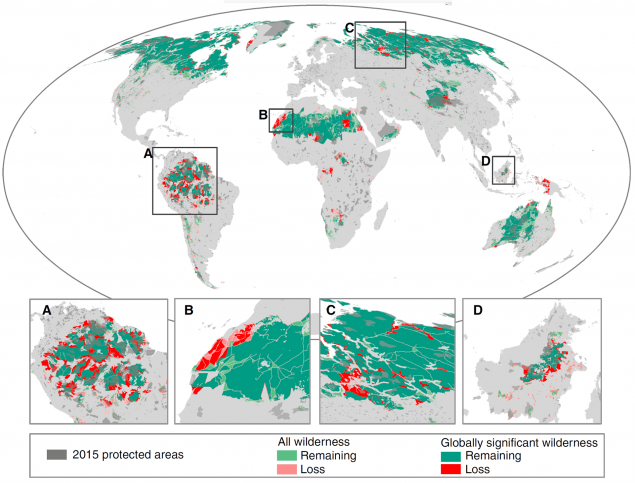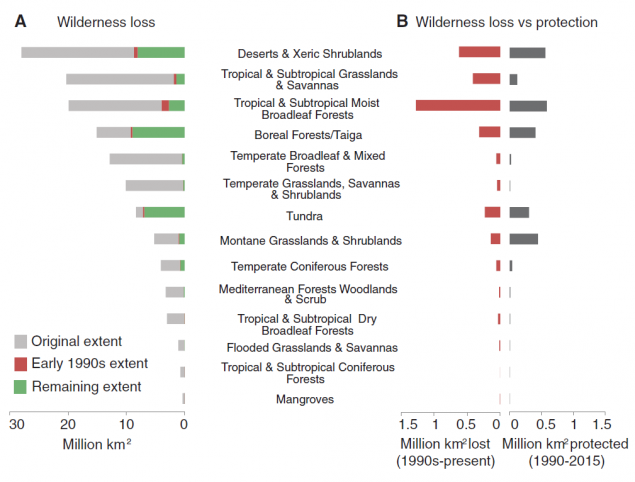10% of wildlife destroyed in 25 years. Well done, people
 Bashny.Net
Bashny.Net

The change of the area of unspoiled nature with the beginning of the 1990s to 2015 (in light red and light green), including the "globally significant" large plots of more than 10 000 km2 (dark red and dark green)
People are actively changing the ecosystem of the Earth for several centuries. However, still on the planet remains relatively untouched area of wild nature where ecological and evolutionary processes occur with minimal human participation. These areas of wild nature is crucial for humanity as critical bastions that support a diversity of species, bind and store excess CO2, soften and regulate the climate. Despite this, the region of wildlife world almost completely ignored by the political establishment, these areas are almost never included in international agreements on environmental issues. It is believed that wildlife is relatively safe from destructive human activity. Therefore, it is not a priority for conservation action. This is a big mistake.
A group of scientists from the University of Queensland in Brisbane (Australia), the environmental organization Wildlife Conservation Society (USA), University. James cook, University. Griffith (both Australia) and the University of Northern British Columbia (Canada) published a scientific paper in which challenge this thesis. They made a comparative map of the areas wildlife on the Land as of 1993 and 2015, using the method of assessment of human influence on the environment, which takes into account population density, a change in the landscape (rivers, coasts, roads and Railways, power lines, etc. According to established methodology from the map untouched nature excluded Antarctica and other ecoregions covered by rocks, ice and lakes.
At this metodolgii, wildlife is now 30.1 million km2 or 23.2% of earth's land area and are situated primarily in North America, Northern Asia (Siberia), North Africa and Australia.
Since the beginning of 1990-x years the planet has lost 3.3 million km2 of unspoilt nature, i.e. about 9.6% of the total.
The reduction of pristine areas affects "globally significant" areas of untouched nature — these are areas larger than 10 000 km2. Such erosion were 74% of large natural blocks. As a result, 37 out of 350 globally important for mankind of large areas of wild nature left for a lower limit of 10,000 km2 and are now considered globally significant. The world's largest natural block Amazonia declined from 1.8 million km2 1.3 million km2. In 3 of the earth's 14 terrestrial biomes in General are no remaining areas of untouched nature, more than 10 000 km2.
It should be noted that "pristine nature" does not mean complete absence of man. Quite the contrary, many of the wilderness areas represent the most important conditions for the survival of small local ethnic groups. These tribes do not spoil the environment, can even improve natural diversity.
Scientists have noted alarming rates of decline in the total area of untouched nature in the world about 10%, especially in the Amazon (30%) and Central Africa (14%).
The research note that over the same time period from 1990-ies till nowadays marked by increased activity on protection of the environment. But it's not helping. The diagram shows that the area of lost wildlife almost everywhere greater than the area put under guard. On a global scale lost 3.3 million km2, and placed under the protection of 2.5 million km2

It can be concluded that this activity does not bring result: either people try to protect what really needs protection, or our efforts are not enough.
Environmentalists urge immediate adoption of the international agreement, which affirms the global importance of unspoiled nature and unparalleled threat, which it is exposed. We must act quickly and on a global scale.
It is known that forest on the Ground ties a significant portion of terrestrial carbon. In plants involves approximately 1950 petagram of carbon (1 000 000 950 000 tonnes). This is more than in the atmosphere (PG 598), coal (PG 446), Gaza (383 Ng) and oil (PG 173). Only one Amazon account 228,7 PG of carbon. Forest conservation, especially in pristine natural areas, it is very important to stabilize atmospheric concentration of CO2.
Wild regions need protection from the people, otherwise it can dramatically affect the CO2 emissions. For example, due to human-induced fires in Borneo and Sumatra in 1997, the atmosphere was thrown more than 1 PG of CO2, which is approximately 10% of the average annual emissions of anthropogenic mankind in the epoch of the Quaternary.
If you talk about an era of the anthropocene, when human activities affect many system processes on Earth, unspoilt natural areas are natural laboratories where we can study ecological and evolutionary effects of global changes that occur because of the person. This kind of "control points", which can be compared to other areas, where it continues intensive development and exploitation of the lands for purposes of civilization.
As soon as large areas of intact ecosystems are becoming increasingly rare, their value increases. The loss of wildlife is an important global problem with very unpredictable consequences for humans and nature, scientists say. If nothing is done, and the current trend continues, by the end of this century on Earth can not stay untouched nature area of over 10,000 km2.
Proactive protection of the remaining wildlife regions on Earth the only way. "You can't restore wild nature. If she disappeared, if over ecological processes that maintain these ecosystems, they can never be returned to its original state. The only option is proactive protection, " says James Watson (James Watson) from the University of Queensland, one of the authors of the study. We have a duty to act for the sake of our children and their children."
Scientific work “Catastrophic Declines in Wilderness Areas Undermine the Global Environment Targets” published in the journal Current Biology (doi: 10.1016/j.cub.2016.08.049).
Source: geektimes.ru/post/280314/
Tags
See also
Fox Kamchatka. Festival wildlife photographers Montier-en-Der
Green advertising: how much is a life worth?
The most ugly insect in the world
Interesting stories about animals
The number of wild animals on the planet over the past 40 years has been halved
Photo project "disappearance". Wildlife Art Wolfe (16 photos)
Wildlife Photography
For wildlife the man was worse than radiation
















